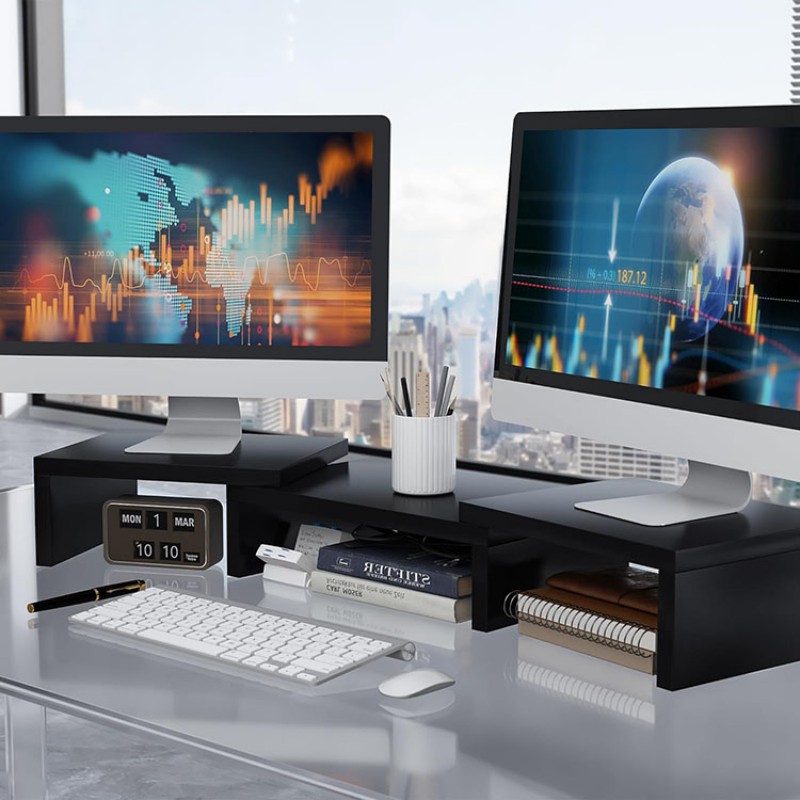Do I Need A Monitor Stand
In the modern workspace, a monitor is more than just a screen; it's your primary portal for work, creativity, and connection. How you position it is fundamental to your comfort, health, and productivity. While many desks include a basic stand, a dedicated monitor arm or stand can be a transformative upgrade.
1. The Ergonomic Imperative: Health and Comfort
This is the most compelling reason to consider a monitor stand.
Achieve Perfect Eye Level: The top of your screen should be at or slightly below your eye level when you are sitting upright. Most built-in stands place monitors too low, forcing you to crane your neck downward, which leads to strain and poor posture over time.
Full Range of Motion: A quality monitor arm allows you to effortlessly adjust the height, tilt, swivel, and even pull the monitor closer or push it farther away. This dynamic adjustability lets you find the perfect viewing angle for any task, whether you're sitting up straight or leaning back in your chair.
Reduced Neck and Back Pain: By promoting a neutral spine and neck position, an ergonomically placed monitor can significantly reduce the risk of chronic pain associated with long hours at a desk.
2. Space Optimization: Reclaim Your Desk
A monitor's built-in base is often large and cumbersome, consuming valuable real estate on your worksurface.
Free Up Surface Area: By replacing the stock stand with a sleek arm or a smaller-footprint riser, you instantly liberate a substantial amount of space for notebooks, your keyboard, a coffee cup, or other essentials.
Cleaner, Minimalist Aesthetic: Monitor arms tuck neatly behind the display, eliminating visual clutter and creating a more streamlined, professional-looking workspace. This is a key principle of modern, efficient desk design.
3. Enhanced Functionality and Flexibility
Monitor Stands adapt to how you work, not the other way around.
Ideal for Multi-Monitor Setups: If you use more than one screen, a dual or triple monitor arm is almost essential. It allows you to align the screens seamlessly, eliminate the gap created by large stands, and position each monitor independently for a cohesive, immersive experience.
Adapt to Different Tasks: Pull your monitor close for detailed design work, then push it back for a broader view. Swivel it easily to share your screen with a colleague. This flexibility is impossible with a fixed stand.
Improved Cable Management: Most high-quality monitor arms include built-in channels or clips to route cables neatly, preventing them from dangling behind your desk and contributing to a tidy setup.
4. Stability and Performance
Eliminate Shake and Wobble: A monitor mounted on a solid, well-engineered arm is remarkably sTable. Typing or bumping the desk will cause far less screen shake compared to a monitor on a standard stand, which can be distracting and frustrating.
VESA Compatibility: Ensure your monitor has a VESA mount pattern (a square set of screw holes on the back) before purchasing an arm. Most modern monitors have this feature, making them compatible with a vast ecosystem of stands and arms.
5. Types of Monitor Stands
Monitor Arms (Clamp or Grommet Mount): Offer the highest degree of flexibility and space savings. They are ideal for single or multiple monitors and provide the full range of ergonomic adjustments.
Monitor Risers (Standing Desks): These are simple platforms that sit directly on your desk, lifting the entire monitor and its original base. They offer basic height adjustment and create storage space underneath for a keyboard or notebooks, but they lack the advanced articulation of an arm.
Conclusion: So, Do You Need One?
While not an absolute necessity, a monitor stand is a highly recommended upgrade for anyone who:
Spends long hours working at a computer.
Experiences neck, back, or eye strain.
Uses a multi-monitor setup.
Values a clean, organized, and spacious desk.
Requires flexibility in their workspace for collaboration or different tasks.
Choosing the right monitor arm is an effective tool for your health and work efficiency. If you have any questions about custom monitor arms, please feel free to contact us.

Previous: How To Decorate A Bookcase Without Books

